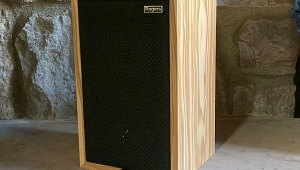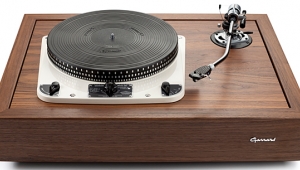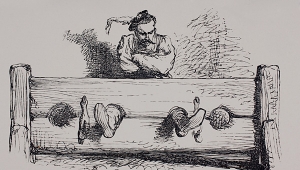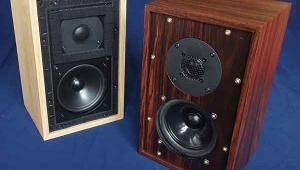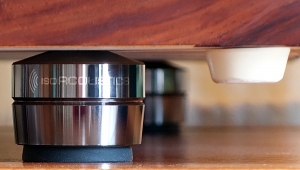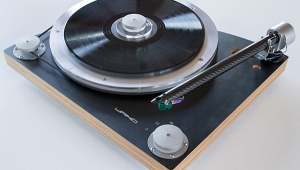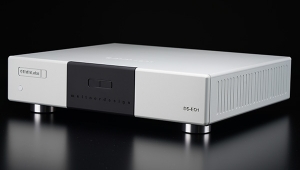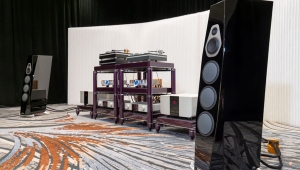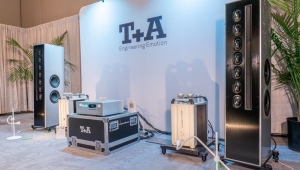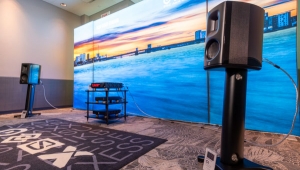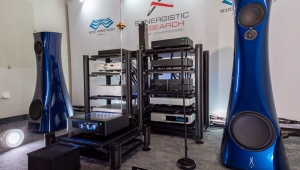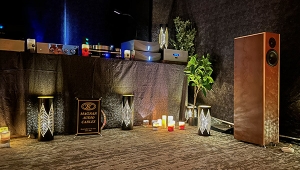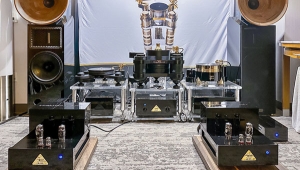| Columns Retired Columns & Blogs |
Listening #94 Page 2
At the other end of the chassis, short pieces of Shindo's own silver interconnect take the signal from a 250k ohm Cosmos volume pot to the signal grid of a Telefunken EF800: an industrial-grade pentode tube that's operated here as a triode, with its secondary and tertiary grids bridged to the plate. The Vosne-Romanee uses just one EF800 per channel, both tubes mounted in spring-loaded sockets to help resist vibrations.
The output of that Telefunken tube is capacitively coupled—through a Sprague Vitamin Q cap—to a Siemens C3m pentode. The C3m is a metal-can tube designed for the German telephone utility, and intended for long life while producing very low noise. (According to Jac van de Walle's excellent website, http://jacmusic.com, it was first made by Siemens for use in underwater repeater amplifiers; Telefunken, Philips, and other European companies subsequently made and sold C3ms of their own.) The C3m is also capable of very high gain, but Ken Shindo puts it to a different sort of use: In the Vosne-Romanee, the Siemens tube functions as a resistance-coupled phase inverter, the output of which appears across the anode and the cathode.

The now-balanced signals for the left and right channels are directed to that pair of vintage output transformers, with DC blocking along the way by those large, lovely, and similarly ancient Sprague oil caps. Absent any technical information about those transformers, I don't know what connection possibilities they offer the designer. (The only relevant spec I can offer is the Vosne-Romanee's output impedance, stated on the Shindo Laboratory website: 600 ohms.) That said, it seems possible to get a true balanced output from this preamplifier's XLR output jacks.
Like most of its companions in the Shindo line, the Vosne-Romanee is a full-featured preamplifier: It has separate, switch-selectable input pairs for moving-magnet and moving-coil cartridges, the latter of which addresses those green-strapped Lundahl trannies. As I've come to expect, Ken Shindo dislikes doing things the same way twice, lacking a good enough reason to the contrary; consequently, the V-R's phono gain and EQ circuits are quite different from those of both the Masseto and Aurieges. In this upscale model, phono signals go first to a General Electric 6072 dual-triode, itself an even lower-noise version of the more common 12AY7. (Both 6072s are covered with metal cans for noise rejection; in light of the fact that even used 6072s can cost more than $100 apiece these days, not to mention that NOS samples are virtually impossible to find, I came to see those cans as an effort in investment protection as well.) The second and final phono tube per channel is the more common Philips 6189, which speaks to the rest of the preamp through a delightful Sprague Black Beauty capacitor.
With carefree style
One Shindo characteristic isn't obvious during a casual walk-through: As I mentioned earlier, Ken Shindo tends to more or less perpetually rethink his product designs. As with other designers, that often coaxes a completely new model into being, but with Shindo it can also result in running changes from one production batch to the next—or even within the same batch. My own Corton-Charlemagne monoblock amplifiers (serial nos. 009 and 010) are good examples of the latter: Silkscreened legends identify the tube types on most Shindo amps, but on my Corton-Charlemagnes, the 12AY7 input triodes are identified with adhesive labels (printed, amazingly, in gold type on metallic green tape); beneath those labels are the silkscreened tube descriptions, identifying the original input tubes as EF183 pentodes. Shindo Laboratory is a brand where the phrase "Specifications are subject to change without notice" has deeper-than-average meaning.
For those and other reasons, when a friend offered to help perform some measurements on the Vosne-Romanee—in truth, he did the vast majority of the work while I assisted, mostly by staying the hell out of the way—we kept our hurdles low. First we set a Krohn-Hite signal generator for 1kHz at 2V output and fed it to the Vosne-Romanee's CD input jacks. Then we connected the preamp to a Heathkit audio analyzer, set for a 50k ohm load, and a Hewlett-Packard dual-trace oscilloscope. We brought up the volume just to the point of clipping and noted an output of approximately 5.5V RMS (which translates to just under 8V peak, possibly explaining the output level spec provided for the V-R on the Shindo site). The wave clipped asymmetrically, flattening at the bottom before the top—a quirk often associated with single-ended outputs, but really not conclusive evidence of anything.
Driving both channels of the Vosne-Romanee, we used the H-P's vertical position control to superimpose one channel's waveform over that of the other, then moved the volume control slowly through its range in an effort to see how the left and right portions of the control tracked each other. The answer: nearly perfectly. Then we plotted the V-R's frequency response, noting 3dB-down points at 21Hz and 26kHz. Incidentally, we saw nothing that looked like transformer saturation: an unscientific observation, of course, on a par with "I didn't see anything in this ultrasound that looked like a gallstone." There are more advanced ways of doing both, I guess.
Speaking of which: With the input shorted and the volume set for full output voltage as above (with a 2V RMS signal), we observed a noise level of about 5mV. We lacked the means to isolate noise bandwidth, but it appeared to be very high-frequency stuff. (Hum, for its part, was practically unmeasurable.) Then again, since all of the test equipment is almost as old as Barbara Walters, it's safe to assume that not all that noise had its origins in the device under test.
- Log in or register to post comments


